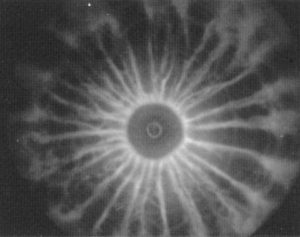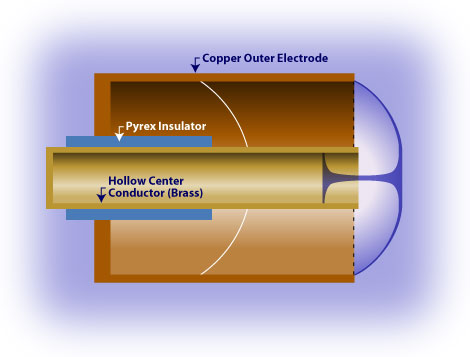A dense plasma focus (DPF) (also plasma gun) is a plasma machine that produces, by electromagnetic acceleration and compression, short-lived plasma that is so hot and dense that it becomes a copious multi-radiation source. It was invented in the early 1960s by J.W. Mather,[1] and also independently by N.V. Filippov.[2] It is also called a high-intensity plasma gun device (HIPGD), or just plasma gun. The electromagnetic compression of a plasma is called a “pinch“.
Contents
Applications

Intense bursts of X-rays and charged particles are emitted, as are nuclear fusion neutrons, when operated in deuterium. There is ongoing research that demonstrates potential applications as a soft X-ray source for next-generation microelectronics lithography, surface micromachining, pulsed X-ray and neutron source for medical and security inspection applications and materials modification, among others.
Other applications include simulation of nuclear explosions (for testing of the electronic equipment) and a short and intense neutron source useful for non-contact discovery or inspection of nuclear materials (uranium, plutonium).
Positive characteristics
An important characteristic of the dense plasma focus is that the energy density of the focused plasma is practically a constant over the whole range of machines, from sub-kilojoule machines to megajoule machines, when these machines are tuned for optimal operation. This means that a small table-top-sized plasma focus machine produces essentially the same plasma characteristics (temperature and density) as the largest plasma focus. Of course the larger machine will produce the larger volume of focused plasma with a corresponding longer lifetime and more radiation yield.
Even the smallest plasma focus has essentially the same dynamic characteristics as larger machines, producing the same plasma characteristics and the same radiation products and radiation characteristics. This is due to the scalability of plasma phenomena.
See also plasmoid, the self-contained magnetic plasma ball that may be produced by a dense plasma focus.
How it works
The charged bank of electrical capacitors (also called a Marx bank or Marx generator) is switched onto the anode. The gas breaks down. A rapidly rising electric current flows across the backwall electrical insulator, axisymmetrically, as depicted by the path (labeled 1) as shown in the Fig 1. The axisymmetric sheath of plasma current lifts off the insulator due to the interaction of the current with its own magnetic field (J×B force). The plasma sheath is accelerated axially, to position 2, and then to position 3, ending the axial phase of the device.
The whole process proceeds at many times the speed of sound in the ambient gas. As the current sheath continues to move axially, the portion in contact with the anode slides across the face of the anode, axisymmetrically. When the imploding front of the shock wave coalesces onto the axis, a reflected shock front emanates from the axis until it meets the driving current sheath which then forms the axisymmetric boundary of the ‘pinched’ or focused hot plasma column.
The dense plasma column (akin to the Z-pinch) rapidly “pinches” and undergoes instabilities and breaks up. The intense electromagnetic and particle bursts, collectively referred to as ‘multi-radiation’ occur during the dense plasma and breakup phases. These critical phases last typically tens of nanoseconds for a small (kJ, 100 kA) focus to around a microsecond for a large (MJ, several MA) focus.
The whole process, including axial and radial phases, may last, for the Mather DPF, a few microseconds (for a small focus) to 10 microseconds (for a large focus). A Filippov focus has a very short axial phase compared to a Mather focus.
Design parameters
The fact that the plasma energy density is constant throughout the range of plasma focus devices, from big to small, is related to the value of a design parameter that needs to be kept at a certain value if the plasma focus is to operate efficiently. The critical ‘speed’ design parameter is \({{I \over a} \over \sqrt{p}}\), or the current linear density divided by the square root of the mass density of the fill gas.
For example for neutron-optimised operation in deuterium the value of this critical parameter, experimentally observed over a range of machines from kilojoules to hundreds of kilojoules, is: 90 (kA/cm)/(Torr)1/2 (780 kA/(m·Pa1/2)) with a remarkably small deviation of 10% over such a large range of sizes of machines.
Thus if we have a peak current of 180 kA we require an anode radius of 1 cm with a deuterium fill pressure of 4 torrs. The length of the anode has then to be matched to the risetime of the capacitor current in order to allow an average axial transit speed of the current sheath of just over 5cm/microsec. Thus a capacitor risetime of 3 microsecond requires a matched anode length of 16 cm.
The above example of peak current of 180 kA rising in 3 µs, anode radius and length of respectively 1 and 16 cm are close to the design parameters of the UNU/ICTP PFF (United Nations University/International Centre for Theoretical Physics Plasma Fusion Facility)[1]. This small table-top device was designed as a low-cost integrated experimental system for training and transfer to initiate/strengthen experimental plasma research in developing countries [2].
Current research
There is now a network (coordinated by the Asian African Association for Plasma Training, AAAPT) of 10 such identical DPF machines, operating in some 8 countries producing postgraduate students and research papers in machine optimization and diagnostics (soft x-rays, neutrons, electron and ion beams), applications (microlithography, micromachining, materials modification and fabrication, imaging and medical, astrophysical simulation) and modeling and computation.
This DPF network was organised by S. Lee from 1986, taking advantage of the fact that even a small DPF can be used to study all the plasma phenomena that a big DPF has access to.
The International Centre for Dense Magnetised Plasmas (ICDMP) in Warsaw. Poland, operates several plasma focus machines for an international research and training programme. Among these machines is one with energy capacity of 1 MJ making it one of the largest plasma focus device in the world.
DPF for nuclear fusion power
Several groups have claimed the DPF could prove viable for fusion power, even producing temperatures high enough for p+B11 fusion, and that the powerful magnetic field can reduce electron-ion collisions and thus reduce bremsstrahlung losses. On the other hand, the high magnetic field is likely to aggravate cyclotron radiation losses. Another advantage claimed is the capability of direct conversion of the energy of the fusion products into electricity, with an efficiency potentially above 70%. So far only minor experiments and computer simulations have been done to investigate the capability of DPF for fusion power.
History
- 1958: Hannes Alfvén: Proceedings of the Second International Conference on Peaceful Uses of Atomic Energy (United Nations), 31, 3
- 1960: H Alfven, L Lindberg and P Mitlid, “Experiments with plasma rings” (1961) Journal of Nuclear Energy. Part C, Plasma Physics, Accelerators, Thermonuclear Research, Volume 1, Issue 3, pp. 116-120
- 1960: Lindberg, L., E. Witalis and C. T. Jacobsen, “Experiments with plasma rings” (1960) Nature 185:452.
- 1961: Hannes Alfvén: Plasma Ring Experiment in “On the Origin of Cosmic Magnetic Fields” (1961) Astrophysical Journal, vol. 133, p.1049
- 1961: Lindberg, L. & Jacobsen, C., “On the Amplification of the Poloidal Magnetic Flux in a Plasma” (1961) Astrophysical Journal, vol. 133, p.1043
- 1962: Filippov. N.V., et al, “Dense, High-Temperature Plasma in a Non-cylindrical Z-pinch Compression” (1962) ‘Nuclear Fusion Supplement’. Pt. 2, 577
- 1969: Buckwald, Robert Allen, “Dense Plasma Focus Formation by Disk Symmetry” (1969) Thesis, Ohio State University.
See also
- Marshall gun, [3]
Footnotes
- ↑ “J. W. Mather, “Formation of a High-Density Deuterium Plasma Focus“, Physics of Fluids, February 1965, Volume 8, Issue 2, pp. 366-377
- ↑ Filippov. N.V., et al, “Dense, High-Temperature Plasma in a Noncylindrical Z-pinch Compression” (1962) ‘Nuclear Fusion Supplement’. Pt. 2, 577
- ↑ P K Browning, in “Observational Plasma Astrophysics: Five Years of Yohkoh and Beyond” (1998) By Tetsuya Watanabe, Takeo Kosugi, Alphonse C. Sterling
References
Plasma gun mechanism on Io
- Peratt, Anthony L.; Dessler, A. J., “Filamentation of volcanic plumes on the Jovian satellite Io”, Astrophysics and Space Science (ISSN 0004-640X), vol. 144, no. 1-2, May 1988, p. 451-461. (Abstract and full text)
External links
- Plasma Radiation Source Lab at the National Institute of Education in Singapore
- Plasma Focus Laboratory, International Centre for Dense Magnetised Plasmas, Warsaw, Poland
- Paper by Leopoldo Soto (Chilean Nuclear Energy Commission, Thermonucluar Plasma Department): New trends and future perspectives on plasma focus research
- Focus Fusion Society
